You searched for: 买球平台,买球网站,买球官网,世界杯买球网址,【世界杯买球官网∶22kk55.com】网上买球规则,网上买球技巧,网上买球地址,2022世界杯怎么买球,如何买球,【赌球平台推荐∶22kk55.com】网址ZCCDBADDgBkn0CEg
<< Previous | Displaying results 51-60 of 248 for "买球平台,买球网站,买球官网,世界杯买球网址,【世界杯买球官网∶22kk55.com】网上买球规则,网上买球技巧,网上买球地址,2022世界杯怎么买球,如何买球,【赌球平台推荐∶22kk55.com】网址ZCCDBADDgBkn0CEg" | Next >>
-
Poster in Hebrew for army recruitment and rescue efforts
PhotoA poster in Hebrew soliciting contributions from members of the Yishuv (the Jewish community of Palestine) for army recruitment and for efforts to rescue European Jewry. The Hebrew text reads "Give a hand in rescue, the Fund for Recruitment and Rescue." Palestine, July 22, 1943.

-
US troops move up to the front to stop the German advance
PhotoDuring the Battle of the Bulge, US troops move up to the front in open trucks in subzero weather to stop the German advance. December 22, 1944. US Army Signal Corps photograph taken by J Malan Heslop.
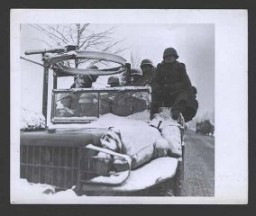
-
A US soldier draws water from a stream with his helmet
PhotoAn American GI using his steel helmet to draw water from a stream during the Battle of the Bulge. December 22, 1944. US Army Signal Corps photograph taken by J Malan Heslop.
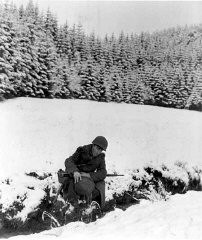
-
A witness testifies about the murder of Catholic priests at Dachau
PhotoFriedrich Hoffman, holding a stack of death records, testifies about the murder of 324 Catholic priests who were exposed to malaria during Nazi medical experiments at the Dachau concentration camp. Dachau, Germany, November 22, 1945.
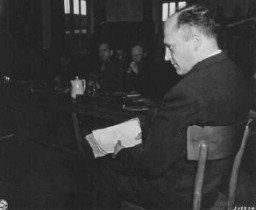
-
Wladislava Karolewska testifies at the Doctors Trial
PhotoWladislava Karolewska, a victim of medical experiments at the Ravensbrück camp, was one of four Polish women who appeared as prosecution witnesses at the Doctors Trial. Nuremberg, Germany, December 22, 1946.
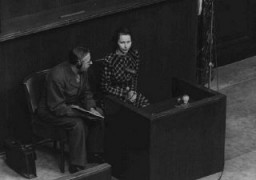
-
Jadwiga Dzido testifies at the Doctors Trial
PhotoConcentration camp survivor Jadwiga Dzido shows her scarred leg to the Nuremberg court, while an expert medical witness explains the nature of the procedures inflicted on her in the Ravensbrück concentration camp on November 22, 1942. The experiments, including injections of highly potent bacteria, were performed by defendants Herta Oberheuser and Fritz Ernst Fischer. December 20, 1946.
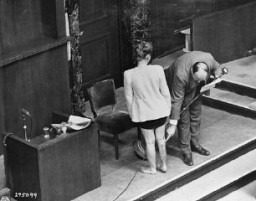
-
Rufus Jones and Clarence Pickettof the American Friends Service Committee (AFSC)
PhotoRufus Jones (seated) and Clarence Pickett were chairman and executive secretary of the American Friends Service Committee (AFSC), respectively. They are pictured here at a Quaker meeting in Philadelphia. The AFSC assisted Jewish and Christian European refugees. Philadelphia, United States, January 22, 1943.
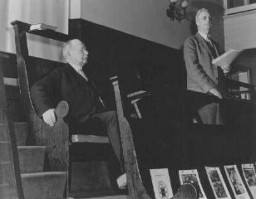
-
French leader Charles de Gaulle in London
PhotoFrench leader Charles de Gaulle in London after France signed an armistice with Germany on June 22, 1940. De Gaulle refused to accept the armistice and led the Free France resistance movement. London, Great Britain, June 25, 1940.
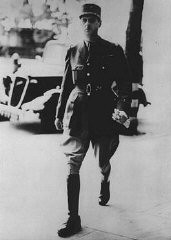
-
Polish-Jewish refugees seeking to leave Europe arrive in Lisbon
PhotoPolish-Jewish refugees seeking to leave Europe arrive in Lisbon. Following the German invasion of France, Jewish and non-Jewish refugee assistance organizations relocated their headquarters to Lisbon, the only neutral European port from which refugees could depart to North and South America. Lisbon, Portugal, June 21-22, 1940.

-
Site of meeting between Neville Chamberlain and Adolf Hitler
PhotoGerman citizens stand outside the decorated Hotel Dreesen, where Neville Chamberlain and Hitler held their second meeting on the Sudetenland and German demands for Czech territory. Nazi flags and the Union Jack fly from the building. Bad Godesberg, Germany, September 22, 1938.

